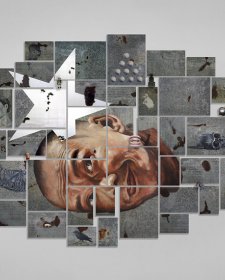She layers appropriated imagery from colonial photography, patterns from Middle Eastern textiles or the Arts and Crafts movement, silhouettes and botanical paintings; these elements combine to comprise the backgrounds and foregrounds of isolated female figures.
Moving to Australia for postgraduate study in 2001, Qureshi’s position as a migrant woman in Australian society has added new layers to her explorations as she continues to push the conventional boundaries of her art form.
She was included in the 5th Asia-Pacific Triennial in 2006, and has exhibited widely in the UK, the United States, Australia and Pakistan. Qureshi lives in Melbourne.
Reflective Looking
An expanded notion of self in the work of Nusra Latif Qureshi
Over the past fifteen years Nusra Latif Qureshi has worked extensively with the tropes and language of Indo-Persian miniature and Company painting, and nineteenth century conventions of portrait photography, to explore the politics of representation in art history.1 Her usually small and often sparingly painted surfaces are ‘teeming with layers of imagery from the past, meanings from the present, and methods from both’.2 Her interest is not so much in ‘righting’ history’s ‘wrongs’, as in pointing to its erasures and highlighting its faded traces. Through her practice, she encourages us to distinguish between what was and what remains; viewing history as a collection of fragments constantly rearranged to construct new narratives.
Qureshi has frequently used the lone female figure as the subject of her work, often inserting it in dialogue with well-known (and usually male dominated) examples of Mughal miniatures. At times, the figure is merely an outline or a collaged cut out – a ghostly annotation to earlier instances of female invisibility. Although not consciously ‘self portraits’, her painted female figures often function as stand-ins for her own subjectivity. And since moving to Melbourne from her native Lahore in 2001, this subjectivity has expanded to include the trials and tribulations of being an immigrant (in a land almost wholly populated by other immigrants).
So while the works in this exhibition represent the most obvious example of Qureshi’s use of her own visage to explore issues of gender and identity through history, an expanded notion of self can be seen in operation through much of her practice.
The two works (or rather bodies of work) in this exhibition mark a distinct new step in her practice, using the same passport photograph of herself as an integral part of both compositions. In the Red silks series of digital prints, she creates digital photomontages incorporating her passport photo, Victorian era dresses, paintings of flowers, exercises in classical calligraphy and other seemingly orientalist ornamentation. The prints are variations on a tightly controlled visual theme built from these same basic components, and when shown together, hint at the process of constructing identity.
The Victorian dresses with their exaggerated shapes speak of the physical constraints placed on the female body in the pursuit of an ideal. This notion of an ‘ideal’ is mirrored in classical calligraphy, where the calligrapher spends a lifetime in pursuit of a perfection against which he (and it is mostly a ‘he’) will be judged. Urdu calligraphy, sharing the script of Arabic, will invariably be read in Western circulation as a reference to Islamic edicts. In fact the ‘calligraphy’ mostly comprises meaningless arrangements of alphabets that are mere exercises. But is this an exercise in search of perfection, or the process by which words that carry religious or cultural conventions get twisted into restraints? Into the strait jacket-like Victorian dresses even.
Did you come here to find history? – a nearly 9 metre long digital print on transparent film – was produced for the 53rd Venice Biennale.3 The artist worked with passport photographs of herself, a nineteenth-century Indian photograph of a young acrobat (who bears an uncanny resemblance to Qureshi) and portraits from both Mughal miniatures and by Venetian painters from the fifteenth to the seventeenth centuries. She superimposes the faces, aligning them at the eyes and so playing with the idea of engaging the viewer’s gaze – images are appropriated and transformed, obscuring, refusing, flexing or sometimes magnifying their original meaning.
The choice of Mughal and Venetian portraits links mercantile history with the history of art and also draws parallels between the decadence and material indulgence of both these trading powers. (Australia’s trading relationship with China is a useful contemporary echo.) The fact that these are portraits that have been preserved for us by art history serves to highlight the privileged level of artistic engagement and circulation – be it of the artist in the courts of the Mughals of India and the Medicis of Venice, or the contemporary artist on the global ‘biennial circuit’. The portraits thus embody not just a time but also a sense of place – both geographic and social. The use of a photo portrait among all the fine painted portraits is also an ironic juxtaposition – for it was the advent of the photographic portrait that rung the death knell for professional miniature painters in nineteenth century India.
Looking at these recent works, and indeed at Qureshi’s work over the last few years, it is instructive to note that both her birth and adopted countries (Pakistan and Australia) are relatively young nations where ‘history’ is clearly in play: where choices of what to highlight and what to hide are hypervisible; where text books are being rewritten; apologies are being made (or not); myths of origin are being deployed or refuted; skeletons are being uncovered or left to rot in mass graves. With this background perhaps these passport photographs, plunged into the heart of these two bodies of work, are not mere examples of the artistic self but a cipher to decoding some of the narratives that these two nations are in the midst of fashioning.
Hammad Nasar
Curatorial Director of Green Cardamom
1 The term ‘Company school’ describes paintings produced in India under the patronage of the East India Company in the late eighteenth and nineteenth centuries. Many former miniature painters employed in Mughal-era courts found themselves in service of Company painting’s documentary focus.
2 Hammad Nasar, ‘Disturbing the order of things’ in Acts of compliance – paintings by Nusra Latif Qureshi, A. Dawood (ed.), London: Green Cardamom, 2005, p. 6.
3 It was shown as part of the exhibition East-West Divan, a collateral project of the 53rd Venice Biennale in 2009.













